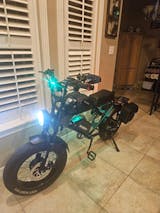Table of Contents
- Why Are Electric Bikes Gaining Popularity in Cities?
- Real Benefits of Electric Bikes for Daily Urban Travel
- Health and Lifestyle Perks of Riding an E-Bike
- Economic Edge: Saving Money With an Electric Bike
- Electric Bikes as a Smart Fix for Urban Traffic
- What to Look For in a City E-Bike for Adults
- Common Questions Adults Ask About Urban E-Bike Use
- Conclusion
Urban living is fast-paced, but commuting can be a full-time job. Between congested buses, increasing gas prices, and traffic that never seems to slow down, even a quick trip can become a headache.
That’s where electric bikes quietly step in and change everything. They're fast, practical, and actually fun to ride. For adults living in crowded urban areas, they offer a smart way to skip traffic, save money, and stay active — all at once.
Why Are Electric Bikes Gaining Popularity in Cities?
Urban areas are packed. Streets are noisy, parking is a nightmare, and public transport can feel like a sardine can on wheels. Adults juggling work, errands, or school runs are looking for faster, easier ways to get around without losing their minds — or their wallets.
That’s exactly why urban electric bikes are turning heads. They let you glide past traffic, park just about anywhere, and skip crowded buses altogether. It's no surprise the demand for a commuter e-bike for adults is climbing fast, especially in cities where short-distance travel is a daily routine.
A lightweight commuter e-bike can handle narrow lanes and stop-and-go traffic better than most cars. Plus, they’re quiet. You won’t wake the whole block when heading out early. With more people now rethinking how they move around, the shift toward eco friendly e-bike travel isn’t just a trend — it’s a real solution.
According to industry reports, e-bike sales in urban zones jumped by over 25% in the past two years. Why? Because they’re not just convenient — they’re practical, clean, and cost-friendly. And when you add in low maintenance and zero fuel stops, they make even more sense.
E-Bike vs Car – Urban Travel Comparison
|
Feature |
Electric Bike |
Car |
|
Average Speed (Urban) |
12–20 mph |
10–15 mph (with traffic) |
|
Parking Required |
No |
Yes (often paid) |
|
Fuel/Charging Cost (Weekly) |
$1–$3 (charging) |
$25–$50 (fuel) |
|
Ease in Narrow Streets |
High |
Low |
|
Environmental Impact |
Low |
High |
Real Benefits of Electric Bikes for Daily Urban Travel
Riding through city streets in a car can feel like crawling. Between red lights, packed intersections, and endless honking, it’s more stop than go. But with a lightweight commuter e-bike, adults can skip all that noise — literally and figuratively.
You don’t need to circle the block for parking. You don’t sit in bumper-to-bumper frustration. Whether it’s getting to the office or picking up groceries, a commuter e-bike for adults turns boring travel into a quick, smooth ride. It works especially well in tight city layouts, where cars are often too much and walking takes too long.
Another win? You're not tied to bus or train schedules. You go when you want — and usually get there faster. For many, an adult city e-bike means freedom, plain and simple. And if you're wondering about hills, the motor does most of the heavy lifting. No sweat. Literally.
Top Benefits of Adult City E-Bike
- Saves time on daily short trips
- Skips traffic jams and road delays
- Needs almost no parking space
- Runs quietly through crowded zones
- Easy to use, even for first-time riders
- Helps cover more distance than walking
- Ideal for errands, work, and casual rides
Health and Lifestyle Perks of Riding an E-Bike
City life is stressful. Long commutes, packed subways, and zero personal space aren’t doing anyone any favors. But hop on a short distance electric bike, and suddenly that daily routine starts to feel lighter — for both your body and your mood.
Even with the motor, you're still pedaling. That light activity adds up, especially if you're using a commuter e-bike for adults every day. Studies show moderate cycling can improve heart health, lower blood pressure, and help maintain a healthy weight. And here’s the bonus: you don’t need a gym membership to get those benefits.
The mental part matters too. Riding a quiet city transport vehicle like an e-bike gives you a break from noise, chaos, and stress. You’re moving under your own control, outdoors, and without the buzz of a crowded bus or the stress of stop-and-go traffic. That’s a win.
Real Ways E-Bikes Improve Adult Lifestyles
1. Builds light physical activity into your routine
2. Cuts down daily stress from traffic
3. Supports better sleep and mental clarity
4. Boosts mood through regular outdoor movement
5. Encourages time-efficient errands and outings
6. Makes commuting less draining and more enjoyable
7. Keeps riders active without joint strain
Economic Edge: Saving Money With an Electric Bike
Let’s face it — owning a car in the city is like setting money on fire. Between gas, insurance, repairs, and parking fees, the costs pile up fast. A folding electric bike for adults, on the other hand, keeps things simple and affordable.
You charge it at home for just a few bucks a week. You don’t need oil changes or brake fluid. And when something does go wrong, repairs are usually minor and cheap. Over time, an affordable city e-bike pays for itself just by skipping gas stations and avoiding parking tickets.
It also helps avoid the rising cost of public transit. Monthly passes and peak-hour surcharges add up. With a commuter e-bike for adults, you ride on your own schedule, without swiping a card every time you leave the house.
Monthly Expense Breakdown – E-Bike vs Public Transit
|
Expense Type |
Electric Bike |
Public Transit |
|
Initial Purchase |
$800–$1,500 (one-time) |
$0 |
|
Monthly Energy Cost |
$3–$5 |
$70–$120 (pass) |
|
Maintenance |
$10–$20 |
Included |
|
Travel Flexibility |
High |
Medium |
|
Annual Estimated Total |
~$200–$250 |
~$900–$1,400 |
Electric Bikes as a Smart Fix for Urban Traffic
If you've ever spent more time at a green light than actually moving forward, you already know the city traffic struggle is real. That’s why more adults are turning to electric bike traffic solution options — because they work.
A compact e-bike model can slide through tight lanes, take shortcuts, and avoid clogged intersections. Unlike cars, which are stuck in line, e-bikes can move freely in bike lanes and side streets. This means less time wasted and more time where you actually want to be — home, work, or grabbing that much-needed coffee.
The rise in urban cycling trends isn’t just about fitness. It’s about smarter mobility. City planners are even adding more bike-friendly routes because they know these bikes help reduce pressure on roads and transit systems. That’s how you know it’s not just hype.
Traffic Problems Solved by E-Bikes
- Avoids gridlock by using dedicated bike lanes
- Reduces the number of cars during rush hour
- Speeds up short commutes in packed city centers
- Cuts down air and noise pollution
- Helps reduce strain on public transport systems
- Allows faster point-to-point travel without stops
- Opens access to car-restricted urban zones
What to Look For in a City E-Bike for Adults
Not all electric bikes are built for city life. Choosing the right one means knowing what actually matters. For daily rides, a step-through electric bike makes getting on and off way easier — especially if you're in work clothes or carrying a bag.
A good commuter e-bike for adults should also be light enough to lift up stairs or into an elevator. Look for models with decent battery range — around 25 to 40 miles is usually more than enough for urban use. And don’t overlook brakes. City riding needs responsive stopping, not guesswork.
Some adults prefer a folding electric bike for adults to save storage space at home or work. Others like the stability of a mini e-bike with fat tires for uneven pavement or curbs. Whatever you choose, make sure it fits your routine — not the other way around.
Must-Have Features in a Commuter E-Bike for Adults
1. Lightweight frame (under 60 lbs is ideal)
2. Step-through design for easy access
3. Battery range of at least 25 miles
4. Reliable disc brakes for quick stops
5. Folding option for storage or travel
6. Comfortable saddle and upright handlebars
7. Built-in lights or reflectors for night rides
8. Compact build for tight city streets
Common Questions Adults Ask About Urban E-Bike Use
A lot of adults are curious about switching to e-bikes, but they’ve got questions — and fair ones. First off: Can you legally ride an electric bike anywhere in the city? In most places, yes. Urban electric bikes are allowed in bike lanes and on roads, but rules can vary, especially around speed limits or throttle use. Always check your local guidelines before riding.
How far can they go? A solid short distance electric bike usually runs between 20 and 40 miles per charge. That’s more than enough for round-trip commutes, errands, or spontaneous lunch runs. Charging is easy too — plug it into a normal outlet and you’re good in just a few hours.
Are they hard to ride? Not at all. The learning curve is short, even if you haven’t touched a bike in years. With pedal assist, you don’t have to push hard. Just start pedaling, and the motor gives you a gentle boost.
Some also ask: Is it okay in the rain? Most commuter e-bike for adults are water-resistant. You don’t want to ride through a flood, but light rain? Totally fine. Just wipe it down afterward and keep the battery dry.
Conclusion
If you’re tired of wasting time in traffic, paying for gas, or squeezing into packed trains, a commuter e-bike for adults might just be the fix. It’s fast, budget-friendly, and doesn’t ask for much — just a charge and a place to park.
From cutting travel time to boosting your mood, the benefits are real. A quiet city transport option like this fits right into busy schedules without adding stress. It’s more than a ride — it’s a better way to move through your day.
Whether it is going to run some errands, commuting to work, or simply wanting to get a breath of air easier in a crowded city, a thinking travel solution such as an electric bike does it all. For most adults, it is now not a matter of "why get one," but "why did I not get one earlier?





















